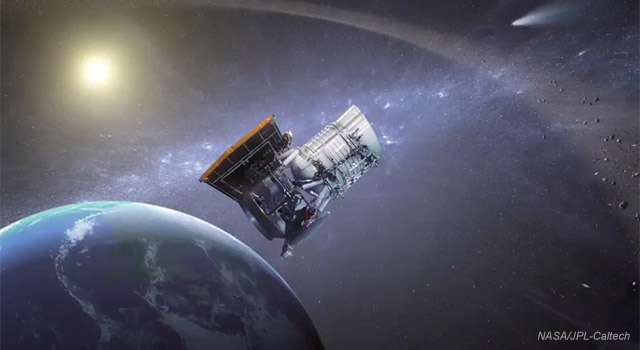NEOWISE 2015 Data Release Now Available
Roc Cutri Caltech, IPAC
The Near-Earth Object Wide-field Infrared Survey Explorer (NEOWISE) and the Infrared Processing and Analysis Center (IPAC) announce the NEOWISE 2015 data release.
The NEOWISE 2015 data release consists of approximately 2.5 million 3.4- and 4.6-micron images and a database of nearly 18.5 billion source detections extracted from those images. These data were acquired during the first year of the NEOWISE reactivation mission (Mainzer et al. 2014, Astrophysical Journal, 792, 30).
NEOWISE scanned the inertial sky nearly two complete times between 13 December 2013 and 13 December 2014, with approximately six months between each survey pass. Twelve or more independent 3.4- and 4.6-micron exposures were made on each point of the sky during each survey epoch. Therefore, the NEOWISE 2015 Data Release is a time-domain archive for extracting multiple, independent thermal flux and position measurements of solar-system small bodies as well as galactic and extragalactic sources.
A guide to the NEOWISE data release, data-access instructions, and supporting documentation is available on the index page. Access to the NEOWISE data products is available via the online and API services of the NASA/IPAC Infrared Science Archive.
NEOWISE utilizes the Wide-field Infrared Survey Explorer (WISE) spacecraft that surveyed the sky in 2010 and was placed into hibernation in February 2011 following the completion of its primary mission. WISE was brought out of hibernation in September 2013 and rechristened NEOWISE with a mission to detect and characterize asteroids and comets and to learn more about the population of near-Earth objects that could pose an impact hazard to Earth. Survey observations were started on 13 December 2013, and the first candidate solar-system moving object detection tracklets were reported to the IAU Minor Planet Center two weeks after the survey start. Three deliveries of tracklets have been made each week since that time, yielding more than 215,000 confirmed detections of nearly 12,000 different solar-system objects to date.
NEOWISE is a project of the Jet Propulsion Laboratory/California Institute of Technology and is funded by the National Aeronautics and Space Administration.


